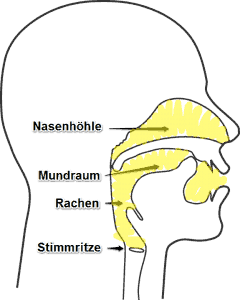Can anyone do that?
Yes, overtone singing can be learned by anyone who can speak.
How do you do that?
Fine tongue movements are used to tune resonating cavities in the mouth and throat exactly to each other while singing normally.
How does overtone singing sound?
Overtone singing sounds like somebody singing two notes at the same time.
Can women do that too?
Yes, women can sing overtones as well as men.
When women’s voices sing an identical pitch as men, e. g. around the A3 (220 Hz), they also have identical overtones and identical possibilities as men. The vocal range of women is on average one octave higher than that of men. However, the singable overtones have the same frequency range for both women and men. This means that in overtone singing, women are more likely to stay in the lower range of the harmonic series, where the overtones are less dense. For complex melodies, women may have to change the fundamental notes more often than men.
Cf.
Does overtone singing harm the voice?
No, overtone singing doesn’t hurt at all, on the contrary!
- Overtone singing trains the voice
- Sharpens the hearing
- Improves fine motor skills of the vocal system
Obertone singing is like normal singing in the larynx and therefore completely harmless. The difference lies in the pronunciation.
In Asian throat singing, however, there are styles such as undertone singing, which should be learned carefully. In addition to the vocal chords, they cause other parts of the larynx to vibrate. A wrong technique can damage the voice under certain circumstances. But of course, this also applies to any other vocal technique, such as pop and opera singing. Correct technique is always important, especially when you sing a lot.
Where does overtone singing originate?
There are several styles that were created independently of each other. A common misconception is that overtone singing comes from Mongolia. Central Asian throat singing comes from this area. However, Western overtone singing and other styles have evolved independently.
How does overtone singing work?
The cause is resonance. The selective control of the formants makes one harmonic from the voice spectrum appear louder than the others.
More about physics?
Formant
A formant is the frequency of a local maximum in the envelope of a sound spectrum. Although many authors use the terms formant and resonance frequency synonymously, they are conceptually different. While formants are a property of the sound spectrum, resonant frequencies are a physical property of the vocal tract (or instrument).
(Harmonic) Sound
Sound in music can mean different things: Timbre, expression, quality.
Sound (complex sound) in physics refers to a chord of harmonic partials. A sound is a natural tone with one pitch and a timbre.
The term sound is used differently in music and physics. This is important for interdisciplinary communication. The same applies to the term tone (pitch). There is no exact translation of the precise physical German term sound into English.
Natural Tone Series
The natural tone series is the series of tones that can be played on valveless wind instruments with a fixed sound tube length by different blowing techniques, e. g. natural trumpet, alphorn, natural horn, overtone flute. The first natural tone corresponds to the fundamental tone of the tube.
The sequence of the natural tone series contains the same tones as those of the natural overtone series. Natural tones, however, are sounds (chords of harmonics), each of which has its own overtones, while the overtones are sine waves that appear as part of a sound and no longer have their own overtones.
Overtone
Overtones are all partials above the fundamental. The counting starts above the fundamental, i. e. the 2nd partial. Therefore, the number of the overtone is always 1 lower than that of the partial. Overtones can be harmonic or inharmonic.
Harmonic Series
The harmonic series is the sequence of harmonic partial tones of a sound.
See detailed article on the harmonic series →
https://en.wikipedia.org/wiki/Harmonic_series_(music)
(Attention, not everything in the Wikipedia article is consistent with my concept! I consider my point of view to be more precise, differentiated and practical, not only in connection with overtone singing.
Pitch Notation
Oktavbezeichnungen
| Oktavbezeichnung | Index-Schreibweise | Apostroph-Schreibweise | wissenschaftliche Schreibweise |
|---|---|---|---|
| Subsubkontra-Oktave | C3oder 3C | ‚‚‚C oder CCCC | C−1 |
| Subkontra-Oktave | C2oder 2C | ‚‚C oder CCC | C0 |
| Kontra-Oktave | C1oder 1C | ‚C oder CC | C1 |
| Große Oktave | C | C | C2 |
| Kleine Oktave | c0oder c | c | C3 |
| Eingestrichene Oktave | c1 | c′ | C4 |
| Zweigestrichene Oktave | c2 | c′′ | C5 |
| Dreigestrichene Oktave | c3 | c′′′ | C6 |
| Viergestrichene Oktave | c4 | c′′′′ | C7 |
| Fünfgestrichene Oktave | c5 | c′′′′′ | C8 |
| Sechsgestrichene Oktave | c6 | c′′′′′′ | C9 |
| Siebengestrichene Oktave | c7 | c′′′′′′′ | C10 |
Helmholtz (German) notation vs. scientific notation.
Partial Tone
A synonym for partial.
Sine Wave
A sine wave is a tone without harmonics.
The waveform is represented by a sine curve (hence the name). This means that the air pressure increases and falls periodically like a sine function.
In physics, a simple tone is only the sine wave. Sine waves do not exist in nature, because natural sounds are always created by vibrating matter, which always produces overtones (harmonic or/and inharmonic) (a reason for this is given by Heisenberg’s uncertainty relation). But electronically, with tuning forks or with whistles you get very close to the sine wave.
https://en.wikipedia.org/wiki/Musical_tone
https://en.wikipedia.org/wiki/Heisenberg%27s_uncertainty_principle
Partial
Partial are all simple tones contained in a sound, including the fundamental and overtones. They are counted upwards from the lowest frequency. Partial tones can be harmonic or inharmonic. Harmonic partials oscillate with integer, non-harmonic partials with non-integer multiples of the fundamental frequency.
https://en.wikipedia.org/wiki/Harmonic_series_(music)#Partial
Tone (Complex Tone)
In music: A tone is a sound event that creates a pitch impression (natural tone). Natural tones have overtones and timbres.
In physics: A tone is a sine wave (simple tone), i. e. a tone without overtones.
When it comes to sinus waves, physics and music agree on the term tone. In physics, however, natural tones are called complex tones or sound mixtures, while in music they are simply called tone. The same applies to the term sound. This is important to note in the dialog.
The physical image of a natural tone contains the consciousness of overtones from the outset. This kind of thinking can be helpful for musicians to learn to deal with the tone more consciously (e. g. choral phonetics).
Complex Sound
A complex sound is composed of sine waves of any frequency, i. e. harmonic and non-harmonic. Noises are complex special forms of a tone mixture. If the partials are in a harmonious relationship to each other, one speaks of a complex tone.
The more inharmonic partials the sound contains, the more it takes on the character of noise.
Complex Tones
When two or more natural tones are mixed, you acutally hear all their partials as a mixed chord. When several tones are played by musical instruments, you hear not only the fundamental tones but also their entire spectrum with all partial tone chords.
Vocal Tract
The vocal tract is the cavity formed by the pharynx, mouth and nasal cavity. It ranges from the glottis to the nostrils and lips. The sound of the voice is formed in this complex tube. Tongue shape, soft palate, lip and jaw opening determine the resonance frequencies through active movement, which produce the volume distribution of the partial tones of the voice.



Leave a Reply
Want to join the discussion?Feel free to contribute!